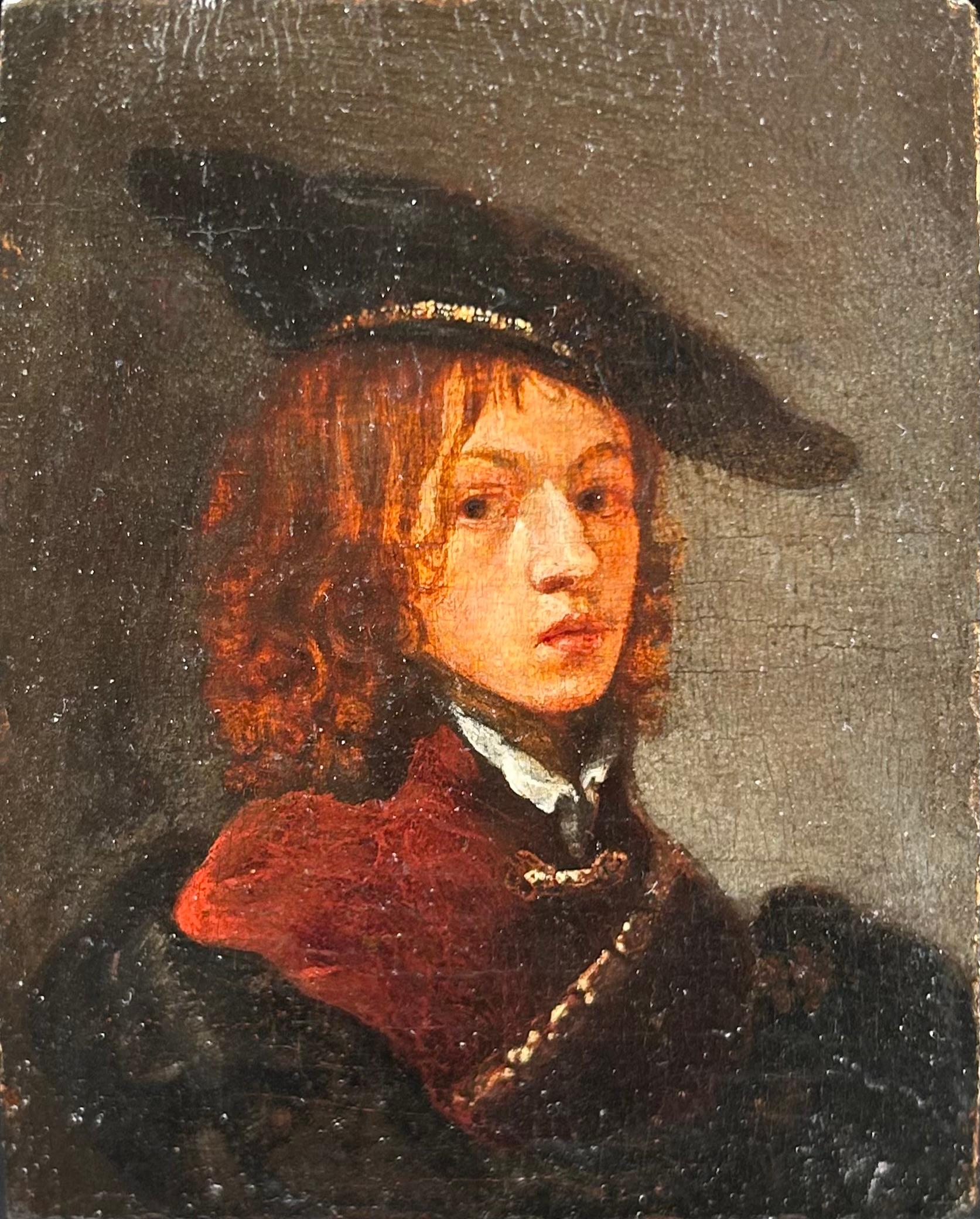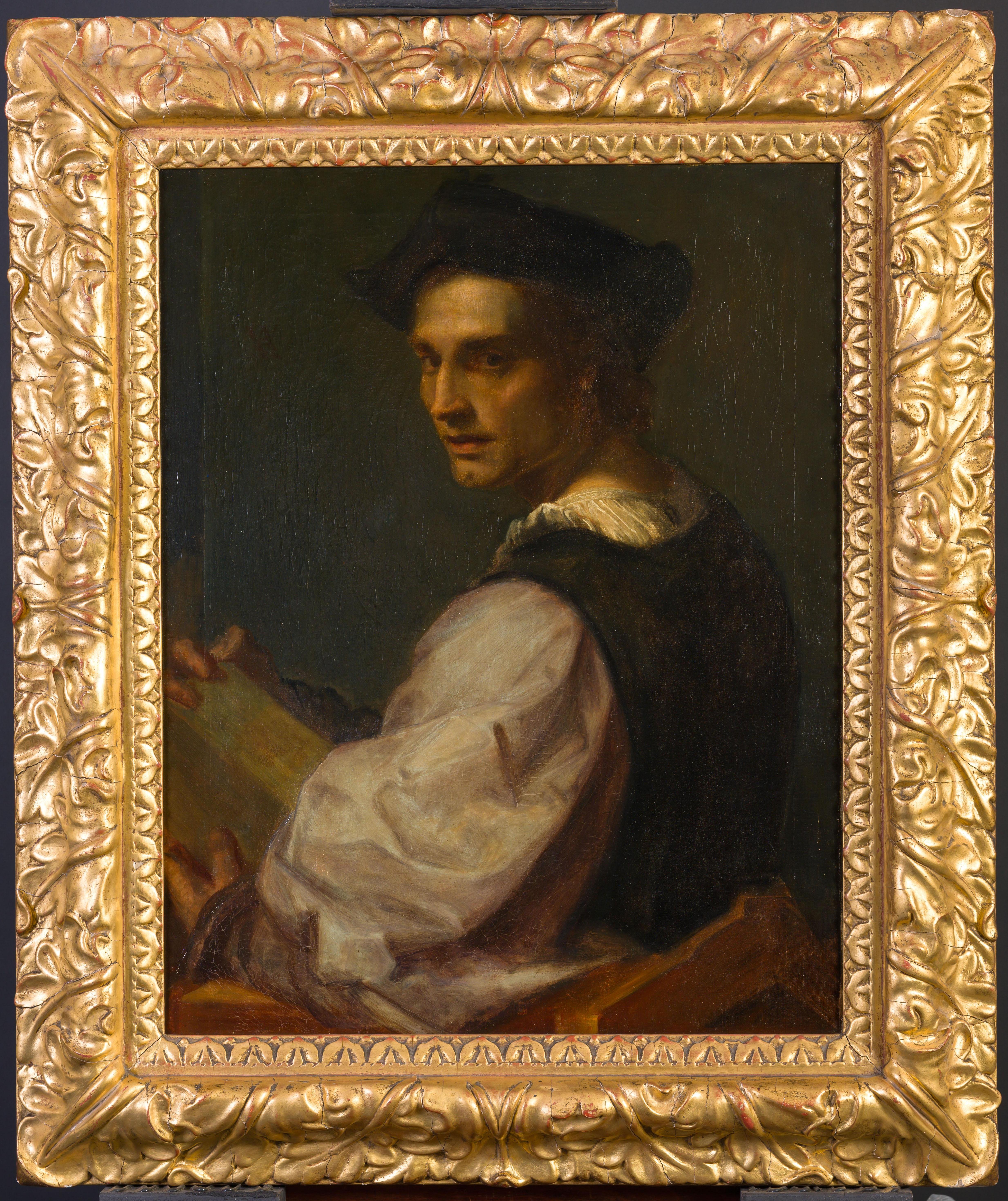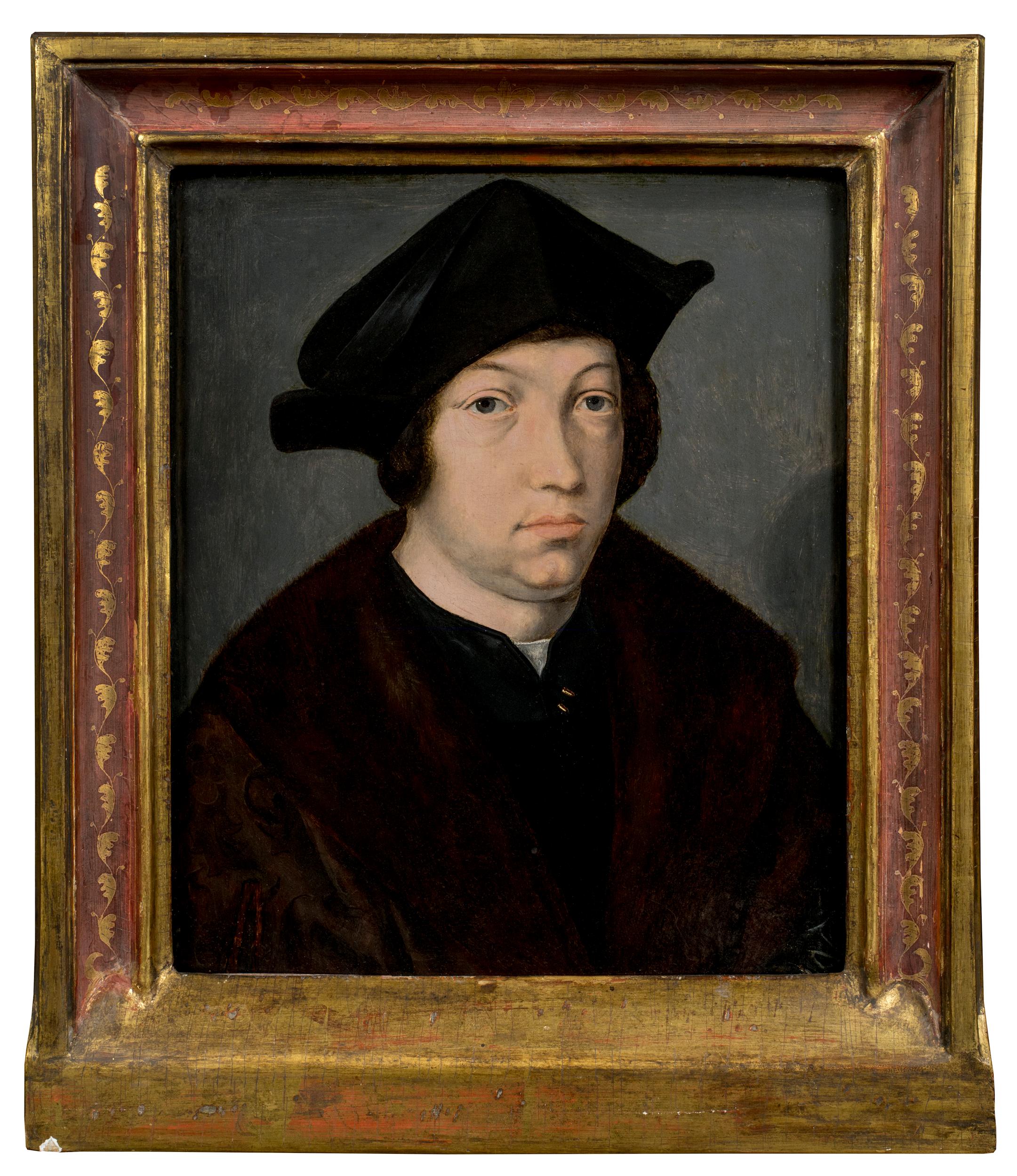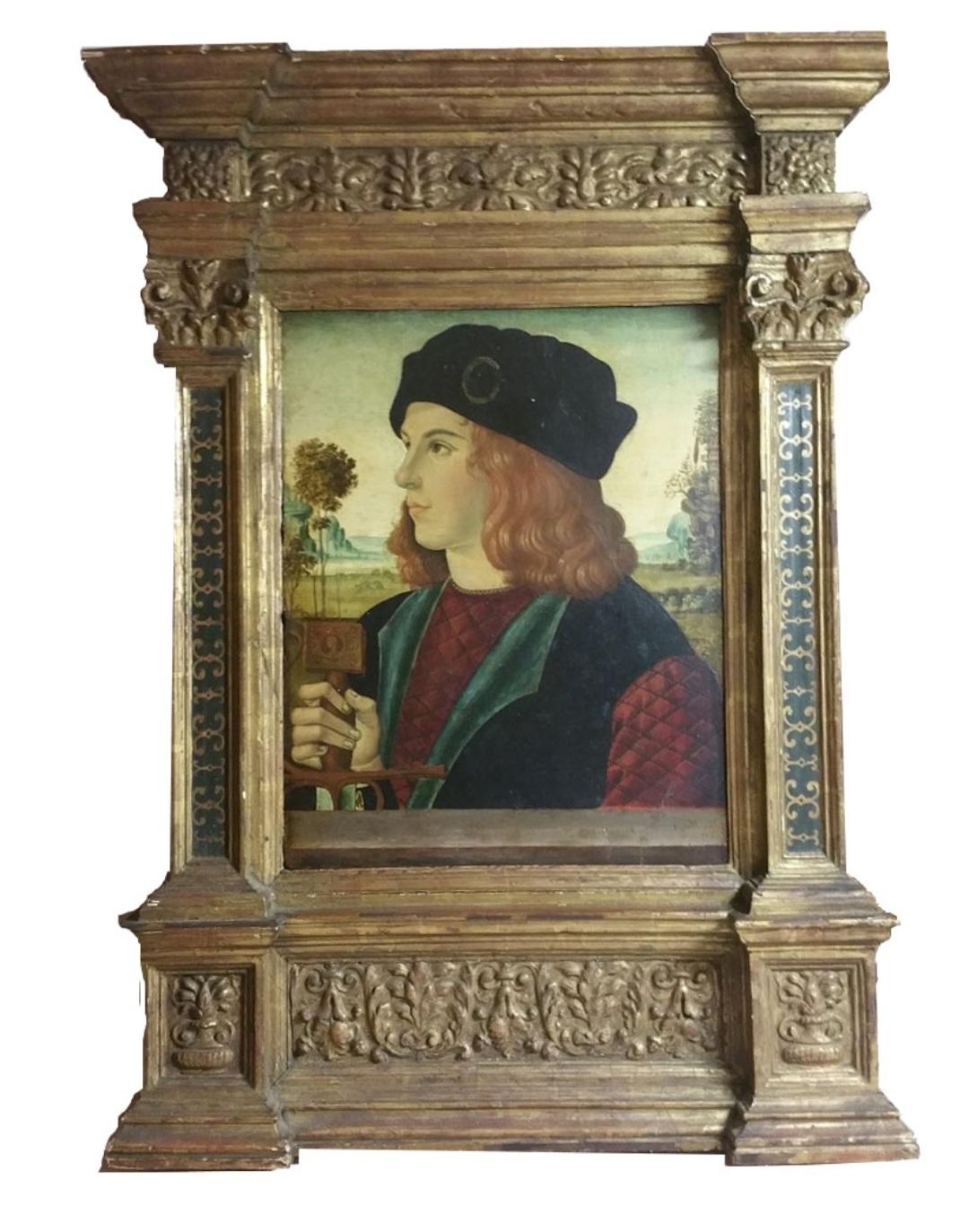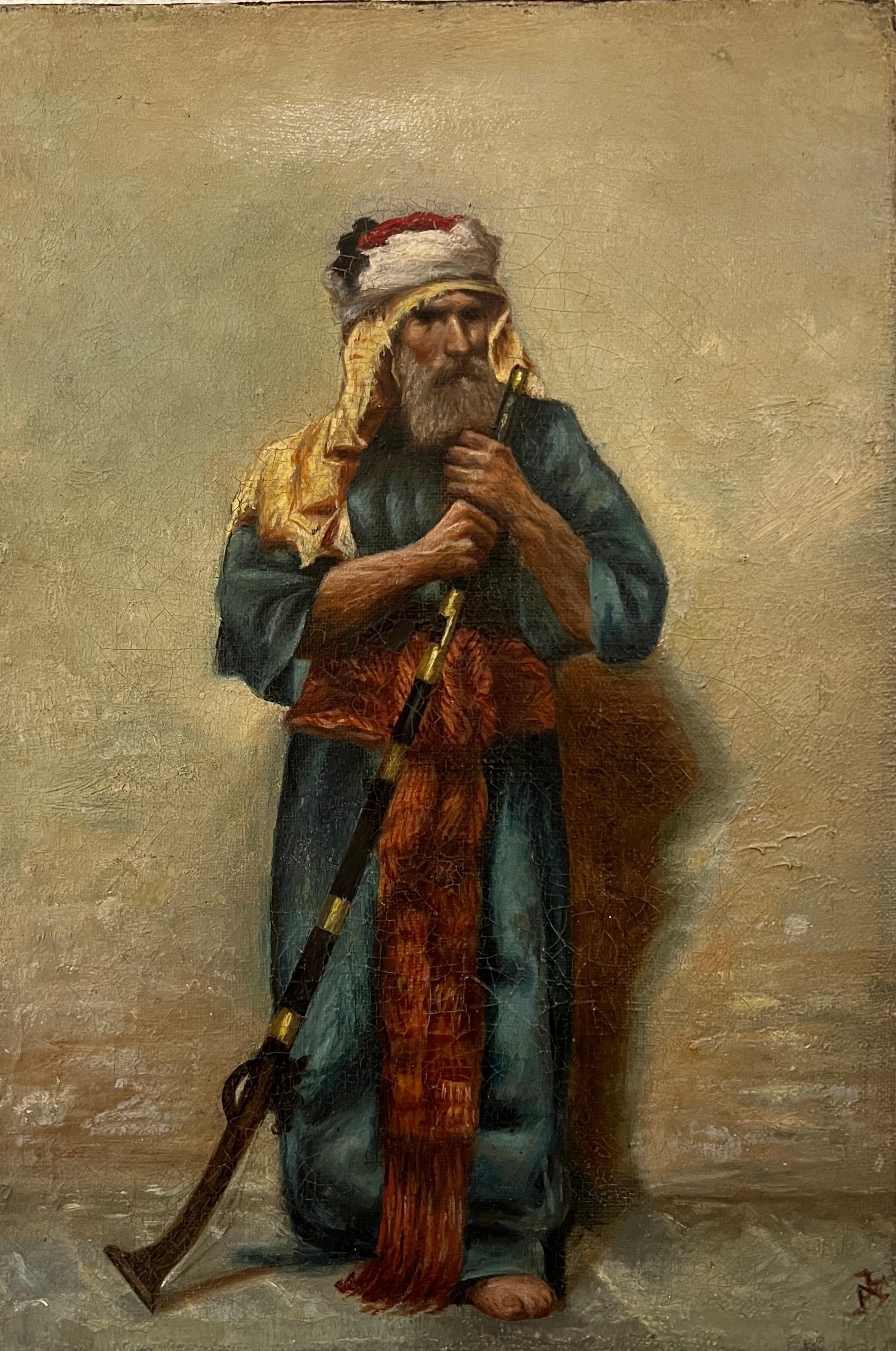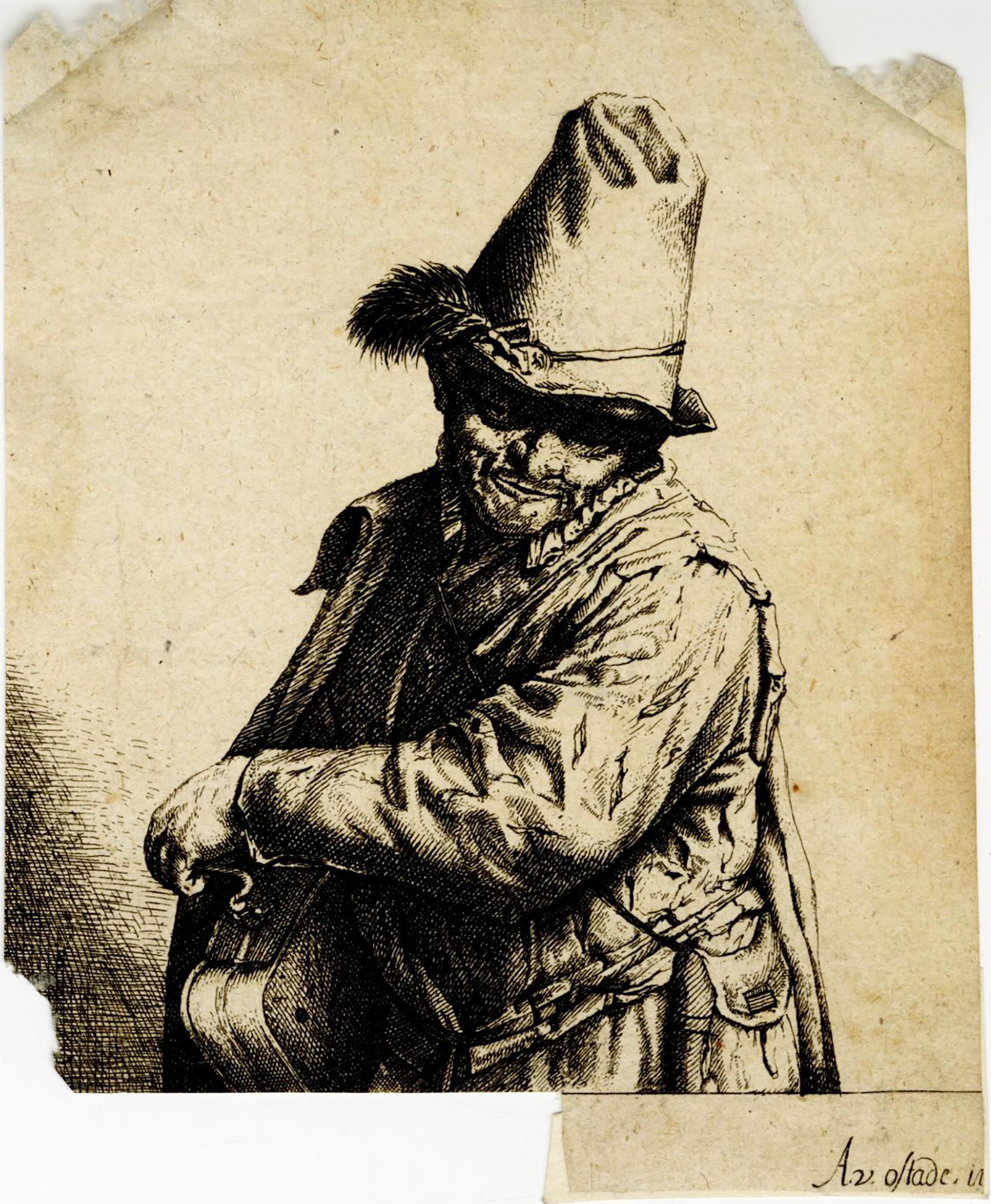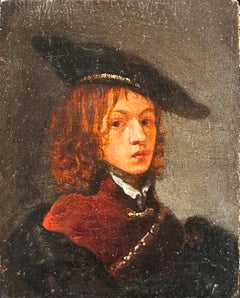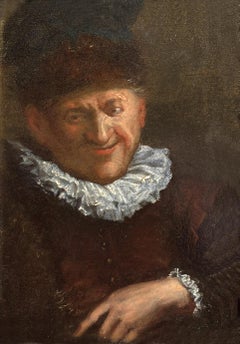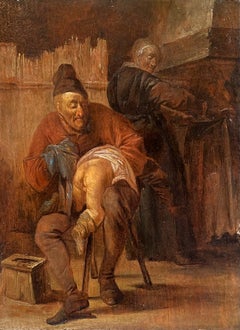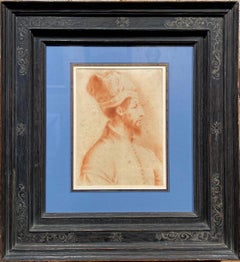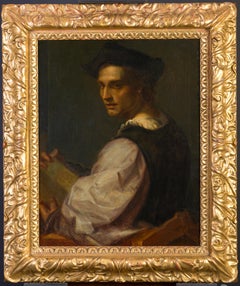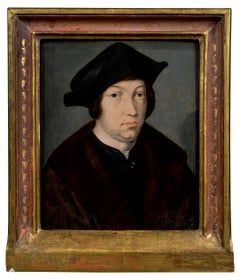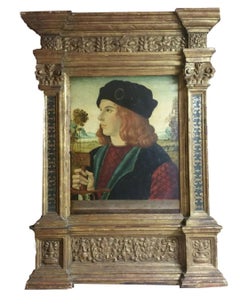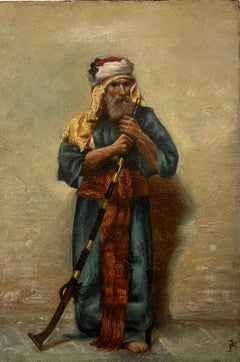Items Similar to The Musician
Want more images or videos?
Request additional images or videos from the seller
1 of 6
The Musician
$15,431.85
£11,200
€13,254.19
CA$21,261.37
A$23,688.17
CHF 12,366.35
MX$287,605.97
NOK 155,436.90
SEK 146,925.64
DKK 98,940.91
About the Item
This head and shoulders portrait is an outstanding example of the breadth, force and beauty of this artist's pictorial manner and abilities. This captivating portrait features a musician holding his recorder, dressed in a dark robe and feathered cap. The recorder appears to be a five-hole Alto Recorder in F-sharp, a popular choice with musicians around the middle of the 18th century.
The man appears to have been playing this instrument just moments before but now has removed it from his lips. One could interpret this position as the man taking a breath between musical bars. However, given the distance between the recorder and the subject's mouth, as well as the wide-eyed gaze that he casts to his left, it is more likely that the sitter has been unexpectedly interrupted.
This dark-shadowed flute player with a brightly lit face acts as a wonderful example of the use of Chiaroscuro. Chiaroscuro, an Italian term which literally means 'light-dark', refers to the dramatic tonal shifts, as seen in this painting, that suggests the modelling and volume of subjects depicted. Here the subtle tonal grading of the body and dress give the figure materiality and three-dimensionality.
Henderick ter Brugghen
(1588 - 1629)
Ter Brugghen was, with Honthorst and Baburen, one of the main Dutch followers of the Italian artist Caravaggio. His family settled in Utrecht, probably in about 1591, where he was a pupil of Abraham Bloemaert. He travelled to Rome in about 1604, within the lifetime of Caravaggio, and remained there until 1614. By 1615 he had returned to Utrecht, where he died in 1629.
Ter Brugghen was the first important painter influenced by Caravaggio to return to Holland. He developed a highly personal style characterised by a soft handling of paint and pale vibrant colouring. He sometimes painted dark figures against a light background, which may have influenced such painters as Vermeer and Fabritius.
His subject matter covered religious, mythological and literary themes, together with representations of picturesque figures, often in domestic settings. His first dated painting is of 1620.
- Dimensions:Height: 25.25 in (64.14 cm)Width: 19.5 in (49.53 cm)
- More Editions & Sizes:1 of 1Price: $15,432
- Medium:
- Circle Of:Hendrick ter Brugghen (1588 - 1629, Dutch)
- Period:Late 17th Century
- Framing:Framing Options Available
- Condition:
- Gallery Location:London, GB
- Reference Number:1stDibs: LU52412176132
About the Seller
5.0
Vetted Professional Seller
Every seller passes strict standards for authenticity and reliability
Established in 2007
1stDibs seller since 2014
82 sales on 1stDibs
Typical response time: 3 hours
- ShippingRetrieving quote...Shipping from: London, United Kingdom
- Return Policy
Authenticity Guarantee
In the unlikely event there’s an issue with an item’s authenticity, contact us within 1 year for a full refund. DetailsMoney-Back Guarantee
If your item is not as described, is damaged in transit, or does not arrive, contact us within 7 days for a full refund. Details24-Hour Cancellation
You have a 24-hour grace period in which to reconsider your purchase, with no questions asked.Vetted Professional Sellers
Our world-class sellers must adhere to strict standards for service and quality, maintaining the integrity of our listings.Price-Match Guarantee
If you find that a seller listed the same item for a lower price elsewhere, we’ll match it.Trusted Global Delivery
Our best-in-class carrier network provides specialized shipping options worldwide, including custom delivery.More From This Seller
View AllPortrait of a Young Man
By (After) Rembrandt van Rijn
Located in London, GB
Pupil of Rembrandt
Portrait of a Young Man
17th Century
Oil on oak panel
Image size: 4 1/4 x 5 inches (11 x 13 cm)
Dutch ebonised frame
This small portrait is of a young man, staring inquisitively out towards the viewer. The realism of his appearance is striking, with great care taken in the depiction of the man’s features - for example, his full lips and the slight bump in the bridge of his nose. The man wears a rich burgundy doublet and a black cap and is adorned with gold accessories, indicating a degree of wealth - it is likely that this is a miniature portrait for a wealthy patron. The warm flesh tones of this painting and the intricate rendering of the man’s curly brown hair demonstrate the artistry of the painter, who has successfully captured the image of youth within his brushstrokes.
Rembrandt’s Pupils
Upon completing his artistic education, Rembrandt opened a studio and began to take students - the first of which were Gerrit Dou and Isaac Jouderville. The studio functioned as an art school, in which materials and guidance were provided - contrary to the studios of his peers, Rembrandt did not offer lodging to his pupils. The families of prospective pupils had to pay Rembrandt 100 guilders (enough for a house at the time) for this artistic education, and the profits from any works produced by pupils under Rembrandt would be paid to the master rather than kept by the student-artist - this contributed substantially to the master’s income.When taking on pupils, Rembrandt looked for those who could already paint, and guided their styles to reflect his. By choosing pupils who were somewhat experienced artists, Rembrandt had an array of painters that could be involved at any stage of assisting with the creation of his works - in this way, Rembrandt’s pupils often functioned as studio assistants as well. In order to perfect Rembrandt’s style, pupils would paint copies of their teacher’s works, sometimes adding their own distinct variations. They would use the same subjects and models as Rembrandt himself, and would accompany him on outdoor trips to paint nature and landscapes. The extensive copying and utilisation of same source materials has rendered Rembrandt’s work and the work of his pupils difficult to differentiate, even in the modern era.At least 50 pupils were taught by Rembrandt, with many continuing on to become his studio assistants. A few graduated into successful artists in their own right - for example, Govaert Flinck...
Category
17th Century Portrait Paintings
Materials
Oak, Oil, Panel
Portrait of a Man, 17th Century Dutch Oil on Panel Portrait
By Cornelis Dusart
Located in London, GB
Circle of Cornelis Dusart
Dutch 1660 - 1704
Portrait of a Man
Oil on panel
Image size: 7¾ x 5¼ inches
Giltwood frame
Cornelis Dusart
Cornelis ...
Category
17th Century Old Masters Portrait Paintings
Materials
Oil, Panel
An Allegory for Smell
Located in London, GB
Dutch School
An Allegory for Smell
17th Century
Oil on canvas
Image size: 19 x 14.5 cm
Dutch ebonised frame
This painting depicts a rather smelly scene - a young boy bent over his f...
Category
17th Century Old Masters Paintings
Materials
Oil, Oak, Panel
Portrait of a Merchant
By Giovanni Francesco Barbieri (Il Guercino)
Located in London, GB
Giovanni Francesco Barbieri Guercino
Italian 1591-1666
Portrait of a Merchant
Sanguine on laid paper
Image size: 12 ¾ x 16 inches (32 x 40....
Category
17th Century Old Masters Portrait Drawings and Watercolors
Materials
Graphite
$19,840
Portrait of an Officer, Cornelius Johnson, 17th Century Old Masters
By Cornelius Johnson
Located in London, GB
Circle of Cornelius Johnson
Circa 1620’s
Portrait of a Officer
Oil on canvas
Image size: 28 x 24 inches
Period style hand made frame
Provenance
Private European Estate
This striking portrait dates to around 1620, as you can see from the images of the sash the detail is very high. The sash is decorated with gold thread and would have cost a small fortune at the time. Sashes were originally developed for a military function (making officers more visible for their men during combat), but soon became a primarily male fashion...
Category
Early 17th Century Old Masters Portrait Paintings
Materials
Oil
Christ as a Boy
Located in London, GB
Attributed to Francesco Bonsignori
Italian 1455-1519
Christ as a Boy
Oil on wood panel
Image size: 12 1/4 x 16 inches (31 x 40.5 cm)
Original gilt frame
In this painting on panel, ...
Category
16th Century Italian School Portrait Paintings
Materials
Oil, Wood Panel
You May Also Like
Portrait of a Sculptor
By Andrea Del Sarto
Located in Douglas, Isle of Man
After Andrea Del Sarto 1486 - 1530, who was an Italian Renaissance painter and draughtsman. Del Sarto worked in Fresco decorating, portrait painting and as a painter of alter pieces,...
Category
Mid-19th Century Portrait Paintings
Materials
Canvas, Oil
Portrait of a Man
Located in New York, NY
Provenance:
with Leo Blumenreich and Julius Böhler, Munich, 1924
Dr. Frederic Goldstein Oppenheimer (1881-1963), San Antonio, Texas; by whom given to:
Abraham M. Adler, New York, until 1985; thence by descent to the present owners
While old inscriptions on the verso of this panel propose its author to be Hans Holbein and the sitter Sir John More—a lawyer, judge, and the father of Sir Thomas More—this fine portrait has long been recognized to be by a Flemish hand. Max Friedländer gave the painting to Bernard van Orley (1487/1491 – 1541) in 1924, but did not include it in the volume dedicated to the artist in his Early Netherlandish Paintings...
Category
16th Century Old Masters Portrait Paintings
Materials
Oil, Panel
$52,500
Portrait of a Young Boy
Located in Saratoga Springs, NY
Attributed Federico Icilio Joni (1866-1946, North Italian Sienese)
“Portrait of a Young Boy”
17 ¾ x 14” (on poplar panel)
Icilio Federico J...
Category
19th Century Old Masters Figurative Paintings
Materials
Panel, Oil
$20,000
Oriental character in costume and instrument
Located in Genève, GE
Work on canvas
AZ monogram
Category
19th Century Figurative Paintings
Materials
Oil
The Organ Grinder
By Adriaen van Ostade
Located in Middletown, NY
Etching on cream laid paper with a large heraldic watermark which is partially trimmed, 4 3/16 x 3 5/8 inches (105 x 84 mm), margins trimmed but preserving the signature in the lower...
Category
17th Century Old Masters Portrait Prints
Materials
Etching
Self Portrait
Located in Douglas, Isle of Man
Sir John Kiffin Williams O.B.E. R.A. 1918-2006, was a Welsh landscape painter. Kiffin Williams as he was known lived on Anglesey and was widely regarded as one of the greatest We...
Category
1960s Portrait Paintings
Materials
Oil, Board
$1,343
More Ways To Browse
Three Musicians
18th Century Family Portrait
17th Century Man Portrait
17th And 18th Century Portraits
17th Century Dutch Portrait Oil Paintings
18th Century Italian Religious Paintings
Robe Feather
Flute Player
Antique Recorders
Abraham Bloemaert
Antique Recorder Instrument
18th Century Painting Of A Lady
Yves Klein Blue
Painting Oil Earl
Diamond Pen
Oil Portrait Irish
Swedish Oil Portrait
Portrait James Ii
